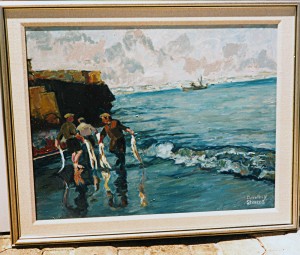
I am not an artist. I always start my introductions with that fact firmly stated. A writer, yes, but I don’t draw, paint, sculpt or otherwise do representational art. My mother, Dorothy Stevens, is a widely recognized painter and sculptor with decades of pieces to show for it. She has studied and taught. Her paintings have been shown in places as diverse as the Office of the Mayor of Cincinnati and the Longboat Key Arts Center. Now in her late 90s, she still ruminates and philosophizes about art and its meanings, and wrote a one-act play to that effect several years ago, aptly titled, “What Is Art?”
My own first “professional” experience began at an art camp at the Cincinnati Art Museum. I was eight. We were a motley crew of rising third-graders sitting outside with our sketchpads and mini-canvases, being taught about perspective, line, color, Monet, and artistic interpretation. Whatever that was.
Mostly, what I remember is snack time, where we were offered what were then-ubiquitous-to-school-lunchroom glass bottles of lukewarm white milk. Which we were to drink with flimsy striped-paper straws that inevitably collapsed under normal sucking conditions.
To this day, the thought of drinking that warm milk makes me sick.
Got Art?
Still, being exposed to art early on has enriched and enlivened my world. I learned to appreciate how everyone can look at the same scene and see something different in it. I learned to focus my attention on details – not just in a painting, but the world around me. I reveled in the skill it took to translate one’s vision on canvas—or through a photograph, in clay or even in a graphic novel or cartoon.
Jack Maypole ©2014
What Would a Michelangelo Create Today?
One might even say that my picking an artist-sculptor-inventor like Leonardo da Vinci around whom to build my Edge of Yesterday science fiction story harkens back to a certain comfort and acceptance of the idea that art and learning go hand-in-hand. And, apparently, the difference in exposure to art—whether through first-hand exposure at an art museum, or just in a classroom, can play a role in later art appreciation.
Now there is some research that backs that up the idea that seeing art in person amplifies the experience.
The study by researchers at the University of Arkansas, reported in the “Education Next” quarterly asked whether there was a difference in learning, understanding and appreciation of paintings with historical significance by third- through 12th-graders—half of whom were randomly selected to visit the Crystal Bridges Museum of American Art in Bentonville, Ark., and the other half who didn’t. Those who were exposed to another painting (not seen in the exhibit) in the classroom, but who did not attend the museum showed lower scores in engagement in observing, interpreting, associating problem finding, comparing and flexible thinking than the group who visited the museum.
Meaning live experience of art in conjunction with teacher preparation for the experience can enhance critical thinking, problem solving, observation, empathy, creativity and focus—all vital skills to educational achievement in every subject.
So, milk aside, maybe those long-ago summer experiences at the Cincinnati Art Museum were good preparation for creating the many storytelling facets of Edge of Yesterday.
Come to think of it, maybe I am an artist, of sorts, after all!
What do you think?
1. Can universal arts education have an impact on learning and engagement for our kids?
a. If so, would you support increased attention to art education and, specifically, to providing arts-enhancement opportunities for field trips to museums, plays, dances, and other arts venues?
b. I think we need more information and research before instituting changes to what is currently available.
c. I don’t know enough about the subject to evaluate.
2. How would you evaluate current exposure to the arts in K-12 learning:
a. Insufficient.
b. Good enough
c. Draws too much time attention from “core” learning
3. What kinds of enrichment programs would you like to see offered for kids, in addition to what is already available?
Feel free to answer these questions in the comments below. We also welcome suggestions for future posts on the subject.

